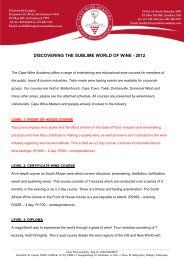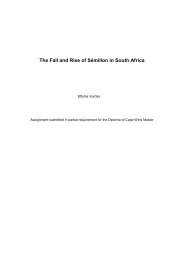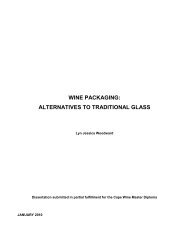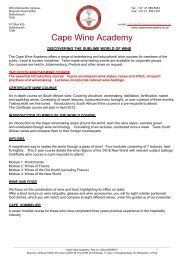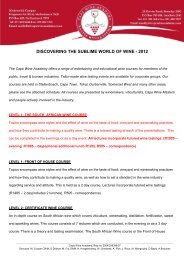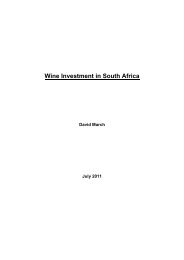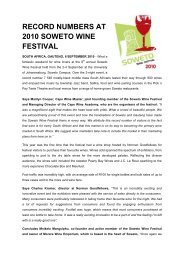micro-oxygenation in contemporary winemaking - Cape Wine ...
micro-oxygenation in contemporary winemaking - Cape Wine ...
micro-oxygenation in contemporary winemaking - Cape Wine ...
You also want an ePaper? Increase the reach of your titles
YUMPU automatically turns print PDFs into web optimized ePapers that Google loves.
Micro-<strong>oxygenation</strong> <strong>in</strong> Contemporary W<strong>in</strong>emak<strong>in</strong>gThese then are the essential benefits of <strong>micro</strong>-<strong>oxygenation</strong> as claimed by the <strong>in</strong>dustry:treat<strong>in</strong>g your red w<strong>in</strong>e with a course of <strong>micro</strong>-<strong>oxygenation</strong> will result <strong>in</strong> a softer, moreaccessible w<strong>in</strong>e with improved colour and better flavour (Parish et al., 2000; Paul, 2002).The advantage of <strong>micro</strong>-<strong>oxygenation</strong> emphasised most prom<strong>in</strong>ently by supporters is theimprovement <strong>in</strong> w<strong>in</strong>e structure. Indeed that was why the technique was orig<strong>in</strong>allydeveloped – to make harsh tannic w<strong>in</strong>es more accessible and ready to dr<strong>in</strong>k earlier. In factthe V<strong>in</strong>ovation promotional material prefers the term ‘<strong>in</strong>tegrated tann<strong>in</strong> management’ to<strong>micro</strong>-<strong>oxygenation</strong> (V<strong>in</strong>ovation, 2001b). It is proposed that treatment with low doses ofoxygen will speed up tann<strong>in</strong> polymerisation result<strong>in</strong>g <strong>in</strong> softer tann<strong>in</strong>s, decreasedastr<strong>in</strong>gency, and an overall improvement <strong>in</strong> mouthfeel.The added oxygen will also promote reactions between anthocyan<strong>in</strong>s and tann<strong>in</strong>s toproduce larger molecules known as polymeric pigments. Polymeric pigments are moredeeply coloured and are more resistant to degradation, effects of pH changes, andbleach<strong>in</strong>g by sulphur dioxide (SO 2 ). So that the overall impact of <strong>micro</strong>-<strong>oxygenation</strong> shouldbe both enhanced red w<strong>in</strong>e colour and more stable colour over time (Paul, 2002).These two benefits, improved palatability and enhanced colour, are more traditionallyachieved by age<strong>in</strong>g red w<strong>in</strong>e <strong>in</strong> oak barrels over a period of months. Although maturation <strong>in</strong>oak barrels will also impart advantageous oak flavours to w<strong>in</strong>e, it was established <strong>in</strong> the1970s and 80s that many of the benefits of barrel-age<strong>in</strong>g are due to the slow diffusion ofoxygen through barrel walls and that the result<strong>in</strong>g low doses of oxygen promote beneficialoxidation reactions which modify w<strong>in</strong>e structure and colour (Atanasova et al., 2002;Cheynier, 2002). Indeed, it was those discoveries that suggested to the <strong>in</strong>ventors of <strong>micro</strong><strong>oxygenation</strong>that low dose oxygen treatment would be an alternative way to achieve thesame outcomes. Therefore, <strong>micro</strong>-<strong>oxygenation</strong> is frequently presented as a substitute forbarrel maturation, with the possible advantages of lower cost, faster maturation, and morescientific control (Jones et al., 2004; Paul and Gore, 2006; Dykes and Kilmart<strong>in</strong>, 2007).With the addition of oak substitutes, such as oak staves or oak chips, it may then bepossible to replicate completely the effects of oak barrel-age<strong>in</strong>g <strong>in</strong> sta<strong>in</strong>less steel tanks,which is an attractive option for w<strong>in</strong>emakers, particularly for medium-range w<strong>in</strong>es(Zoeckle<strong>in</strong> et al., 2002; Goode, 2005).Interest<strong>in</strong>gly, although these changes <strong>in</strong>duced by <strong>micro</strong>-<strong>oxygenation</strong> are <strong>in</strong>terpreted bymany as speed<strong>in</strong>g up the age<strong>in</strong>g of w<strong>in</strong>e (Zoeckle<strong>in</strong> et al., 2003), V<strong>in</strong>ovation takesconsiderable effort <strong>in</strong> their documentation to present it differently. As shown <strong>in</strong> Table 1,11



